
Acacia melanoxylon, commonly known as the Australian blackwood, is an Acacia species native in South eastern Australia. The species is also known as Blackwood, hickory, mudgerabah, Tasmanian blackwood, or blackwood acacia. The tree belongs to the Plurinerves section of Acacia and is one of the most wide-ranging tree species in eastern Australia and is quite variable mostly in the size and shape of the phyllodes.
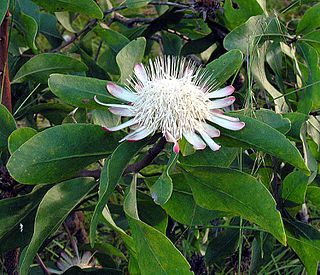
Protea gaguedi is a species of tree which belongs to the genus Protea.

Bacidina is a genus of lichens in the family Ramalinaceae. It was circumscribed by Czech lichenologist Antonín Vězda in 1990, with Bacidina phacodes assigned as the type species. Vězda included 11 species in Bacidina, which was originally classified in the Lecideaceae. These species had previously been placed in genus Bacidia.

Micarea is a genus of lichenized fungi in the family Pilocarpaceae. The widely distributed genus contains 126 species and new species are described actively. Species in the genus are crustose lichens and their photobiont is a single-celled green alga.
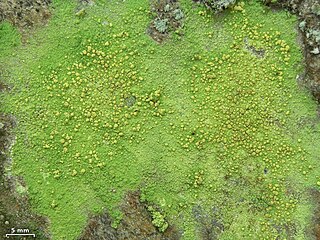
Psilolechia lucida is a species of saxicolous lichen in the family Psilolechiaceae. It is widely distributed through the world, where it grows on natural and artificial rocky substrates in the shade, often in sheltered underhangs. It forms a greenish crust on the surface of its substrate.

Malmidea is a genus of crustose lichens and the type genus of the family Malmideaceae. It was established in 2011 to contain a phylogenetically distinct group of species formerly placed in the genus Malcolmiella. Malmidea comprises more than 50 mostly tropical species that grow on bark, although a few grow on leaves.

Punctelia graminicola is a species of foliose (leafy) lichen in the family Parmeliaceae. It grows on rocks, and, less frequently, on bark in North America, South America, and East Africa. It has a blue-grey thallus measuring up to about 15 cm (6 in), covered with tiny pores called pseudocyphellae. Sometimes the lichen forms small lobes that project out from the surface. Fruiting bodies are uncommon in this species; if present, they resemble small cups with a brown internal disc measuring 3–10 mm (0.1–0.4 in) in diameter. A lookalike species, Punctelia hypoleucites, is not readily distinguishable from Punctelia graminicola by appearance or habitat alone; these species can only be reliably differentiated by examining the length of their conidia.

Parmelia omphalodes is a species of foliose lichen in the family Parmeliaceae. It is one of the several dozen lichen species first described in 1753 by Carl Linnaeus. Swedish lichenologist Erik Acharius transferred it to the genus Parmelia in 1803. The lichen is widely distributed, having been recorded in Asia, Africa, Europe, and North and South Americas. Morphologically similar–but genetically distinct–species include Parmelia discordans and P. pinnatifida.

Loxospora is a genus of lichen-forming fungi in the family Sarrameanaceae. It has 13 species. The genus was circumscribed by Italian lichenologist Abramo Bartolommeo Massalongo in 1852, with Loxospora elatina assigned as the type species. This crustose lichen was originally named Lecanora elatina by Erik Acharius in 1810.

Lepraria incana is a species of dust lichen in the family Stereocaulaceae. First described scientifically by Johann Jacob Dillenius in 1741, and then formally by Carl Linnaeus in 1753, it is the type species of the genus Lepraria. The thallus of this species is green to greyish-green, and powdery – as if made of tiny granules. These granules are soredia, which are asexual reproductive structures. Like most members of genus Lepraria, the lichen has few distinguishing features, lacking both a medulla and sexual reproductive structures (apothecia). Chemically, the lichen is characterised by the presence of the secondary chemicals known as divaricatic acid and zeorin.
Menegazzia bjerkeana is a rare species of foliose lichen in the family Parmeliaceae. It occurs in rainforests along the New South Wales-Queensland border, where it grows on the bark of southern beech trees.
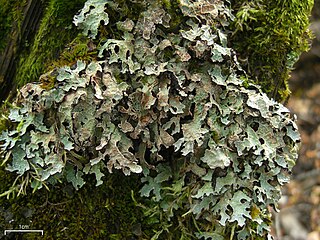
Parmelia barrenoae is a species of foliose lichen in the large family Parmeliaceae. It was formally described as a new species in 2005. Before this, it was lumped together as one of several lichens in the Parmelia sulcata group—a species complex of genetically distinct lookalikes. Parmelia barrenoae is widely distributed, occurring in Europe, western North America, Africa, and Asia.
Parmelia imbricaria is a species of foliose lichen in the family Parmeliaceae. Found in western Canada, it was formally described as a new species in 2017 by Trevor Goward, Pradeep Kumar Divakar, María del Carmen Molina, and Ana Crespo. The type specimen was collected by Goward near the Clearwater River drainage, where it was found at an altitude of 700 m (2,300 ft) growing on a basalt boulder. The specific epithet refers to the "imbricate" lobes of the thallus. The lichen occurs in western Canada, with a range including southern Yukon and extending south to southern inland British Columbia. The European Parmelia pinatifida is a closely related species.

Chrysothrix flavovirens is a species of crustose and corticolous (bark-dwelling) lichen in the family Chrysotrichaceae. It was formally described as a new species in 1994 by Tor Tønsberg as the sorediate counterpart of the common and widespread Chrysothrix candelaris. The type specimen was collected from Kirkeøy, Norway, where it was found growing on Picea abies. It has a pale greenish-yellow thallus that contains rhizocarpic acid. The lichen is widespread in Europe, and has also been recorded from Japan and North America. In the Atlantic and Mediterranean biogeographic regions of Portugal, it prefers to grow on the acidic bark of coastal conifer trees.

Malmidea attenboroughii is a species of corticolous (bark-dwelling), crustose lichen in the family Malmideaceae. It is known to occur from a single location in the Amazon rainforest of Bolivia.
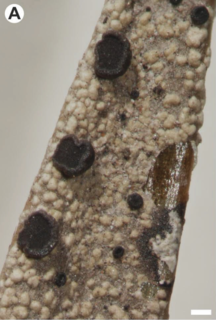
Fuscidea multispora is a species of foliicolous (leaf-dwelling), crustose lichen in the family Fuscideaceae. Found in Bolivia, it is known to occur only in a single high-altitude locality in a national park, where it grows on the leaves of coniferous trees from the genus Podocarpus.
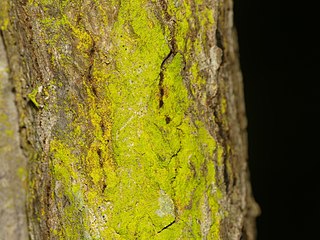
Chrysothrix xanthina is a widely distributed species of leprose lichen in the family Arthoniaceae. It has a bright yellow to bright greenish-yellow, thin, granular thallus, and typically grows on bark, although it is infrequently found growing on rock.
Loxospora cristinae is a fungal species classified in 2018, found in a few European countries. It belongs to the division Ascomycota and the family Sarrameanaceae. It was first identified and described in the 19th century, but the species would not be correctly classified until almost two centuries later. Loxospora cristinae is a sterile crustose lichen, meaning it reproduces by a type of vegetative spore that has evolved specifically to produce morphological structures.
Micarea pauli is a species of corticolous and lignicolous, crustose lichen in the family Pilocarpaceae. It is only known to occur in Poland's Białowieża Forest.
Bacidina flavoleprosa is a species of saxicolous (rock-dwelling), leprose (powdery) lichen in the family Ramalinaceae. It is found in a single locality in the Czech Republic.














